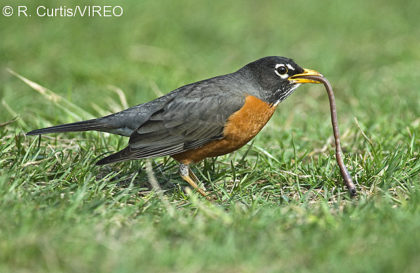 Fred Allebach is a member of the City of Sonoma’s Community Services and Environmental Commission, and an Advisory Committee member of the Sonoma Valley Groundwater Sustainability Agency. Fred is a member of Sonoma Overlook Trail Stewards, as well as Sonoma Valley Housing Group and Transition Sonoma Valley.
Fred Allebach is a member of the City of Sonoma’s Community Services and Environmental Commission, and an Advisory Committee member of the Sonoma Valley Groundwater Sustainability Agency. Fred is a member of Sonoma Overlook Trail Stewards, as well as Sonoma Valley Housing Group and Transition Sonoma Valley.
My back yard

Every year as Spring beckons, the robins return from their mysterious journeys. All of a sudden, they’re here. Harbingers of the season. They like to nest in the thick cover of the trees over by the shed. They follow the seasonal green-up, arriving in places that suit their needs at just the right time to provision their offspring.
Robins look cute, but such cuteness belies their habit of seeking the live flesh of others to feed themselves and their young. Delicate blue eggs bring crying chicks hungry for the life of a worm.
I know the robin’s calls without having to look. Same with the year-round resident towhees and house wrens. There’s lots of birds now, with plenty of natural fare here from the bounty of our yard. I look for them, notice them, watch for their signs. I like having them all around.
It’s tempting to see all this in the yard as “nature”, yet the landscape has an indelible human mark, of exotic, introduced species, grasses in particular. The apparently wild pantheon here is made up of animals that can co-exist with and take advantage of man-made spaces: crows, rats, mice, deer. Then there are those who can take us or leave us: squirrels, grey foxes, coyotes, raccoons, skunks, opossum, bobcats, mountain lions, tree frogs, salamanders, lizards, skunks, snakes, chickadees, hummingbirds. There are plenty I don’t even know.
As people spread out of Africa 70,000 years ago, they left a wake of altered habitats and large mammal extinctions. The wild animals left standing are the ones who could adapt to, or who took advantage of these human alterations. Here’s a thought on wildness: 85% of all mammal biomass is made up of people and domestic animals.
The backyard ecosystem here has to tolerate multiple mowings and human modifications. Leaving tall, dry grass just won’t do because of fire danger. The grass has to be kept down. Five or six mows a year or the grass gets too tall and tough for the old high weed mower to cut. But, the yard is big enough, and some spots hard enough to get, that on “the back 40” a variety of private and unaltered habitats remain.
Whatever the life out in the back yard here is, it seems to get along pretty well on its own, in spite of my conceptions of it. The yard has a life of its own.
Douglas fir, Monterey pine, Italian cypress, redwood, valley oak, coast live oak, hawthorn, many large buckeyes, acacia, a huge old California pepper, maybe the largest walnut in town, quince, almond, apple, fig, olive, plums, and camellia are some of the trees. Then all manner of plants, pink ladies, bushes, oleanders, and small trees planted by former tenants and owners. This land is a shadow and reflection of Sonoma’s mixed ag and rural residential past. There are layers not immediately apparent, days gone and forgotten, enacted on this very ground.
The yard borders Arroyo Seco, now running at full force. Stream courses like Arroyo Seco serve as animal avenues, conduits from the mountains down to the flats. A well-worn animal trail goes right along the creek, and one crosses 8th East into the field across the street. Creatures big and small come through and leave their marks and sign. “Look! I am here.”
One enduring image: nymphs in the creek. One year I saw them, as the rainy season wound down, gliding free in the water, up and down, as if diving around for the pure joy. Did they know the stream was soon to dry up, the pools to be gone, to leave their free and soaring nature but a memory imprinted on empty space?



